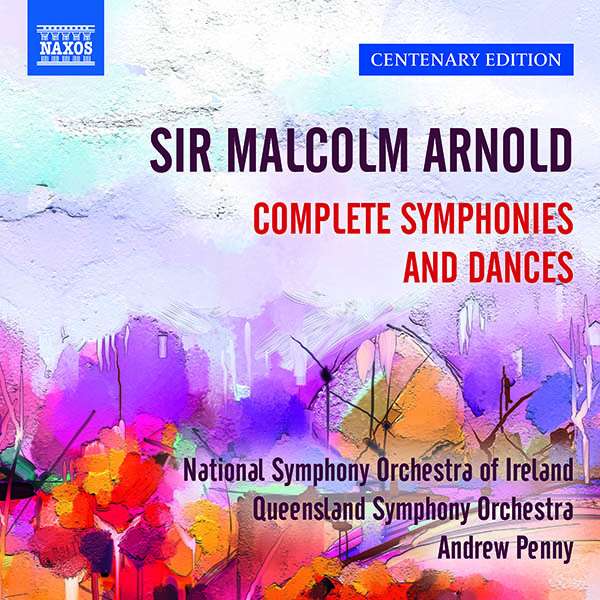(Remy Franck) – Naxos hat die in den Neunzigerjahren auf Einzel-CDs veröffentlichten Symphonien und Tänze von Malcolm Arnold (1921-2006) in einer Box zusammengefasst.
Beispielhaft für die frühen, in ihrer Form sehr klassischen, wenn auch in der Harmonik und in der Orchestrierung moderneren, d.h. spätromantischen Symphonien, seien die mit den Nummern 3 und 4 genannt. Sie werden hier in exzellenten Interpretationen vorgelegt. Andrew Penny, dem die Gesamtaufnahme der Arnold-Symphonien bei Naxos anvertraut wurde, dirigiert die beiden Werke recht forsch zupackend, mit eher schnellen Tempi, kontrastreich und trotz des immensen Orchesterapparats sehr transparent. Dieses Dirigat fördert die Intensität des Musizierens und damit auch die Expressivität. Das spieltechnische Können des sehr guten Nationalen Symphonieorchesters aus Irland kommt dabei vollauf zur Geltung.
(Alain Steffen) – Dass Arnold eine weit bessere Musik komponiert, als man ihm zugesteht, beweisen auch die Symphonien Nr. 7 und 8. Arnold erweist sich als ein mit allen Wassern gewaschener Künstler, der es nicht scheut, seine Werke mit Jazz-Elementen und irischen Volksmelodien anzureichern. Emotionale Intensität, ernsthaftes Grübeln und tragische Elemente weisen auf die Ernsthaftigkeit hin, mit der Arnold seine Symphonien angeht. Andrew Penny und das National Symphony Orchestra of Ireland spielten die Gesamtausgabe der Symphonien in Anwesenheit des Komponisten ein und garantieren Authentizität aus erster Hand. Spieltechnisch sind beide Aufnahmen äußerst gelungen. Penny arbeitet sehr sorgfältig und kann die zwei Werke maximal ausleuchten, ohne sein Orchester zu überfordern.
Malcolm Arnold schrieb auch einige Tänze, und hier sind sie, aufgenommen in Australien vom Queensland Orchestra unter der inspirierten Leitung von Andrew Penny. Das Klangbild ist eher unscharf, und obwohl sich die Aufnahme durch eine gehörige Portion Schwung und beeindruckende Verve auszeichnet, fehlt es ihr an Raffinesse und Eleganz, um mit Arnolds Aufnahmen mit dem London Symphony Orchestra konkurrieren zu können.
(Remy Franck) – Naxos has compiled the symphonies and dances by Malcolm Arnold (1921-2006) released on single CDs in the nineties in a box set.
Exemplary of the early symphonies, very classical in form, though more modern in harmony and orchestration, i.e. late Romantic, are those numbered 3 and 4. They are presented here in excellent interpretations. Andrew Penny, who has been entrusted with the complete recording of the Arnold symphonies on the Naxos label, conducts the two works quite briskly, with rather fast tempi, rich in contrast and, despite the immense orchestral apparatus, very transparent. This conducting emphasizes the intensity of the music-making and thus also the expressivity. The technical skills of the very good National Symphony Orchestra of Ireland are fully appreciated.
(Alain Steffen) – That Arnold composes far better music than he is given credit for is also confirmed by Symphonies Nos. 7 and 8. Arnold proves to be an all-water artist who does not shy away from enriching his works with jazz elements and Irish folk melodies. Emotional intensity, serious brooding and tragic elements indicate the seriousness with which Arnold approaches his symphonies. Andrew Penny and the National Symphony Orchestra of Ireland recorded the complete edition of the symphonies in the presence of the composer, guaranteeing first-hand authenticity. Playing-wise, both performances are extremely successful. Penny’s conducting is very careful and able to illuminate the two works to the maximum without overburdening the orchestra.
Malcolm Arnold also wrote some dances, and here they are, recorded in Australia by the Queensland Orchestra under the inspired direction of Andrew Penny. The sound is rather fuzzy though, and even if the music has a fair amount of verve and élan, it lacks the refinement and elegance to compete with Arnold’s recordings with the London Symphony Orchestra.




















